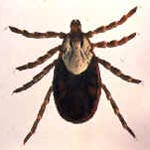Severe fever with thrombocytopenia syndrome (SFTS) – quite a mouthful.
This week’s Journal of the American Medical Association included a few paragraphs on this newly identified infection, caused by a tick-borne Phlebovirus of the Bunyaviridae family.
Other tick-borne illnesses include Rocky Mountain spotted fever, Lyme disease, southern tick-associated rash illness, ehrlichiosis, and tularemia. The image to the right shows Dermacentor andersoni, the vector for Rocky Mountain spotted fever.
SFTS was first seen in central China, where patients developed fever, gastrointestinal distress, and a low platelet count. As many as 30% of infected patients die from the disease. No news yet, whether the virus is headed our way.
Fortunately, it is possible to avoid ticks, by avoiding contact with brush, wooded areas, and high grass. Wear long sleeves and long, light-colored pants, to make it easier to spy ticks crawling on you. Do a full-body check after potential exposure, and check clothing, pets, backpacks, etc. for hitchhiking ticks. Just reading this article may make you want to shower, also a great idea for after a hike through the woods or grassy field.
Beyond avoidance, DEET applied to the skin is protective for several hours. Permethrin can be used to treat clothing or gear, and can last through several washings. It might be a good idea to include these chemicals among your medical supplies.
Since effective antiviral treatment for the virus remains undetermined, the best bet is to avoid or kill the vector.
- To read the article in the New England Journal of Medicine, click HERE.
Related articles
- Ticks linked to deadly virus discovered in China (physorg.com)



